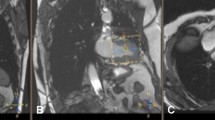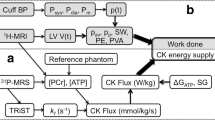Summary
Depletion of high-energy phosphates, accumulation of inorganic phosphate and intracellular acidosis have each been proposed as important events in the transition from reversible to irreversible ischemic injury. To assess whether each variable is predictive of functional recovery on reperfusion, these were measured in the isolated isovolumic rat heart using31P NMR. Perfused hearts were subjected to either 10, 12 or 40 min of normothermic ischemia followed by 40 min of reperfusion. Hearts were then freeze-clamped for further analysis of phosphate metabolites by NMR and ion chromatography. High-energy phosphates, Pi, phosphomonoesters and pH were measured by31P NMR spectroscopy at 2 minute intervals. Heart rate and developed pressure were monitored simultaneously. All hearts undergoing 10 min of ischemia and 40% of hearts subjected to 12 min of ischemia demonstrated good functional recovery. The remainder of hearts ischemic for 12 min went into contracture on reperfusion with little return of function. Hearts subject to 40 min of ischemia went into ischemic contracture and showed no recovery on reperfusion. Intracellular pH, [ATP], and [Pi] measured prior to reperfusion did not predict the extent of recovery. However, phosphomonoesters were detected prior to reperfusion in all hearts that did not recover well, but were not observed in hearts that showed good mechanical recovery. Analysis of tissue extracts by31P NMR and ion chromatography indicated that the most prominent components of the phosphomonoesters were glucose 6-phosphate, α-glycerol phosphate and AMP. In conclusion, of the various phosphorus metabolites that can be measured by31P NMR, only one group, the phosphomonoesters, was predictive of functional recovery.
Similar content being viewed by others
References
Apstein CS, Mueller M, Hood WB (1977) Ventricular contracture and compliance changes with global ischemia and reperfusion, and their effect on coronary resistance in the rat. Circ Res 41:206–217
Bailey IA, Seymour A-ML, Radda GK (1981) A31P NMR study of the effects of reflow on the ischaemic rat heart. Biochim Biophys Acta 637:1–7
Barry WH, Peeters GA, Rasmussen CAF, Cunningham MJ (1987) Role of changes in [Ca2+]i in energy deprivation contracture. Circ Res 61:726–734
Becker LC, Ambrosio G (1987) Myocardial consequences of reperfusion. Prog Cardiovasc Dis 30:23–44
Bottomley PA (1989) Human in vivo NMR spectroscopy in diagnostic medicine: clinical tool or research probe? Radiology 170:1–15
Carter LS, Mueller EA, Norfleet EA, Payne FB, Saltzman LS (1987) Hypothyroidism delays ischemia-induced contracture and adenine nucleotide depletion in rat myocardium. Circ Res 60:649–652
Engler R, Gilpin E (1989) Can superoxide dismutase alter myocardial infarct size? Circulation 79:1137–1142
Gavin JB, Nevalainen TJ, Seelye RN, Webster V, Thomson RW (1978) An association between the onset of rigor and loss of vascular competence in early myocardial infarcts. Pathology 10:19–25
Guth BD, Martin JF, Heusch G, Ross J (1987) Regional myocardial blood flow, function and metabolism using phosphorus-31 nuclear magnetic resonance spectroscopy during ischemia and reperfusion in dogs. J Am Coll Cardiol 10:673–681
Hearse DJ (1979) Reperfusion of the ischemic myocardium. J Mol Cell Cardiol 9:605–616
Hearse DJ, Garlick PB, Humphrey SM (1976) Ischemic contracture of the myocardium: mechanisms and prevention. Am J Cardiol 39:988–993
Humphrey SM, Carter LA, Hollis DG (1987) Critical early metabolic changes associated with myocardial recovery or failure after total ischemia in the rat heart. Basic Res Cardiol 82:304
Humphrey SM, Gavin JB, Herdson PB (1980) The relationship of ischemic contracture to vascular reperfusion in the isolated rat heart. J Mol Cell Cardiol 12:1397–1406
Humphrey SM, Hollis DG, Seelye RN (1984) Adenine pool catabolism in the ischemic, the calcium depleted ischemic, and the substrate-free anoxic isolated rat heart: relationship to contracture development. J Mol Cell Cardiol 16:1127–1136
Jeffrey FMH, Storey CJ, Nunnally RL, Malloy CR (1989) Effect of ischemia on NMR detection of phosphorylated metabolites in the intact rat heart. Biochemistry 28:5323–5326
Jennings RB (1969) Early phase of myocardial ischemic injury and reperfusion. Am J Cardiol 24:753–765
Jennings RB, Steenbergen C (1985) Nucleotide metabolism and cellular damage in myocardial ischemia. Ann Rev Physiol 47:727–749
Kloner RA, Ganote CE, Jennings RB (1974) The “no reflow” phenomenon after temporary coronary occlusion in the dog. J Clin Invest 54:1496–1508
Kloner RA, Reimer KA, Willerson JT, Jennings RB (1976) Reduction of experimental myocardial infarct size with hyperosmolar mannitol. Proc Soc Exp Biol Med 151:677–683
Kubler W, Spieckermann PG (1970) Regulation of glycolysis in the ischemic and anoxic myocardium. J Mol Cell Cardiol 1:351
Malloy CR, Matthews PM, Smith MB, Radda GK (1986) Influence of propranolol on acidosis and high energy phosphates in ischemic myocardium of the rabbit. Cardiovasc Res 20: 710–720
Mathur PP, Case RB (1973) Phosphate loss during reversible myocardial ischemia. J Molec Cell cardiol 5:375–393
Reibel DK, Rovetto MJ (1978) Myocardial ATP synthesis and mechanical function following oxygen deficiency. Am J Physiol 234:H620-H624
Rovetto MJ, Lambreton WF, Neely JR (1973) Mechanisms of glycolytic inhibition in ischemic rat hearts. Circ Res 37:742–751
Sako EY, Kingsley-Hickman PB, From AHL, Foker JE, Ugurbil K (1988) ATP synthesis kinetics and mitochondrial function in the postischemic myocardium as studied by31P NMR. J Biol Chem 263:10600–10607
Seymour A-ML, Bailey IA, Radda GK (1983) A protective effect of insulin on reperfusing the ischemic rat heart shown using31P NMR. Biochim Biophys Acta 762:525–530
Steinmann CML, Lochner A, Niesler RA (1987) Inhibition of contractility during early phase of total ischaemia in the working heart. Recovery during reperfusion. Bas Res Cardiol 82:297–303
Taegtmeyer H, Roberts AFC, Raine AEG (1985) Energy metabolism in reperfused heart muscle: metabolic correlates to return of function. J Am Coll Cardiol 6:864–870
Tranum-Jensen J, Janse MJ, Fiolet JWT, Krieger WJG, d'Alancourt CN, Drner D (1981) Tissue osmolarity, cell swelling and reperfusion in acute regional myocardial ischemia in the isolated porcine heart. Circ Res 49:364–381
Vary TC, Angelakos ET, Schagger SW (1979) Relationship between adenine nucleotide metabolism and irreversible ischemic tissue damage in isolated perfused rat heart. Circ Res 45:218–225
Weishaar RE, Bing RJ (1980) The beneficial effect of a calcium channel blocker diltiazem, on the ischemic-reperfused heart. J Mol Cell Cardiol 12:993–1009
Author information
Authors and Affiliations
Rights and permissions
About this article
Cite this article
Jeffrey, F.M.H., Storey, C.J. & Malloy, C.R. Predicting functional recovery from ischemia in the rat myocardium. Basic Res Cardiol 87, 548–558 (1992). https://doi.org/10.1007/BF00788665
Received:
Accepted:
Issue Date:
DOI: https://doi.org/10.1007/BF00788665




